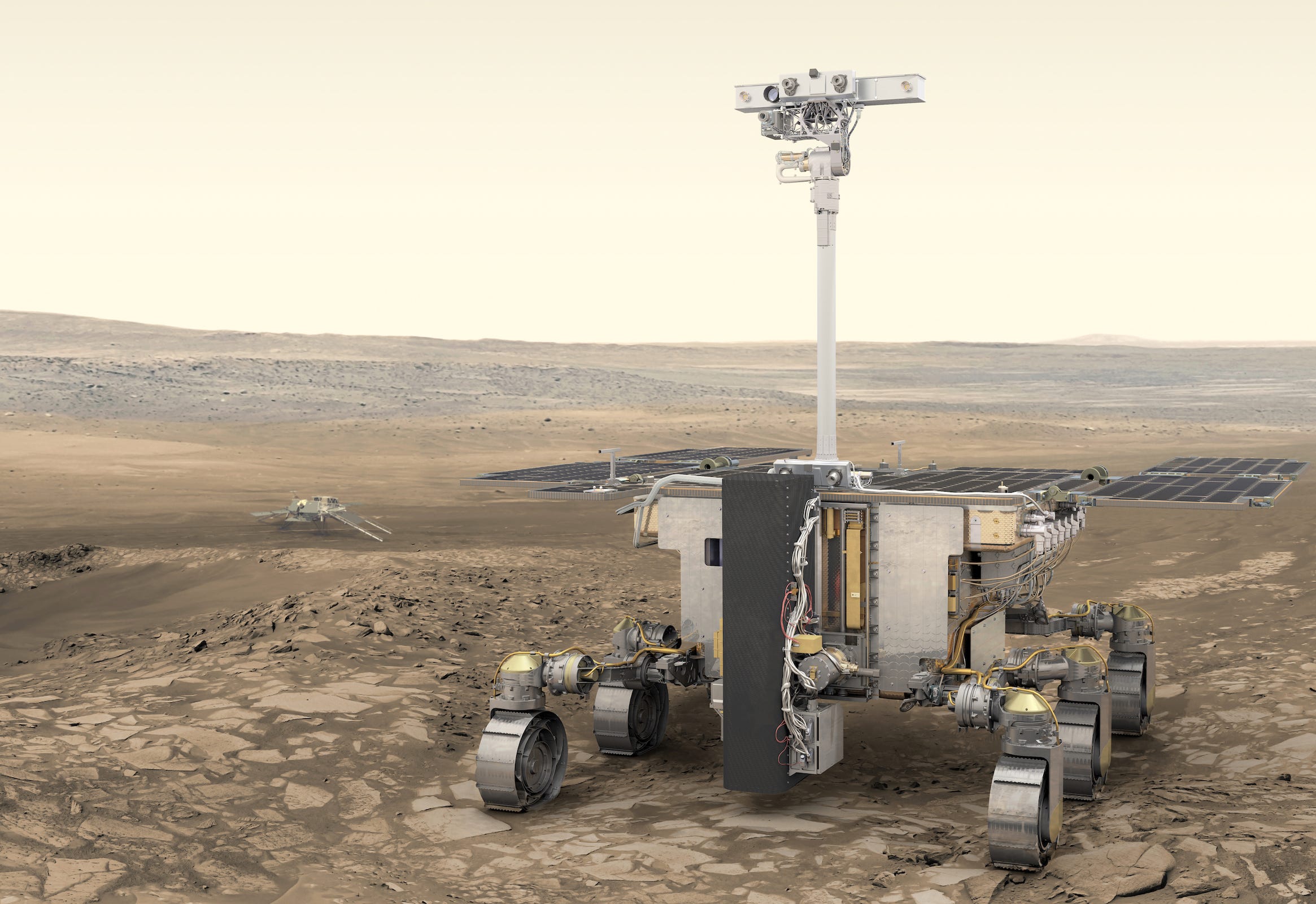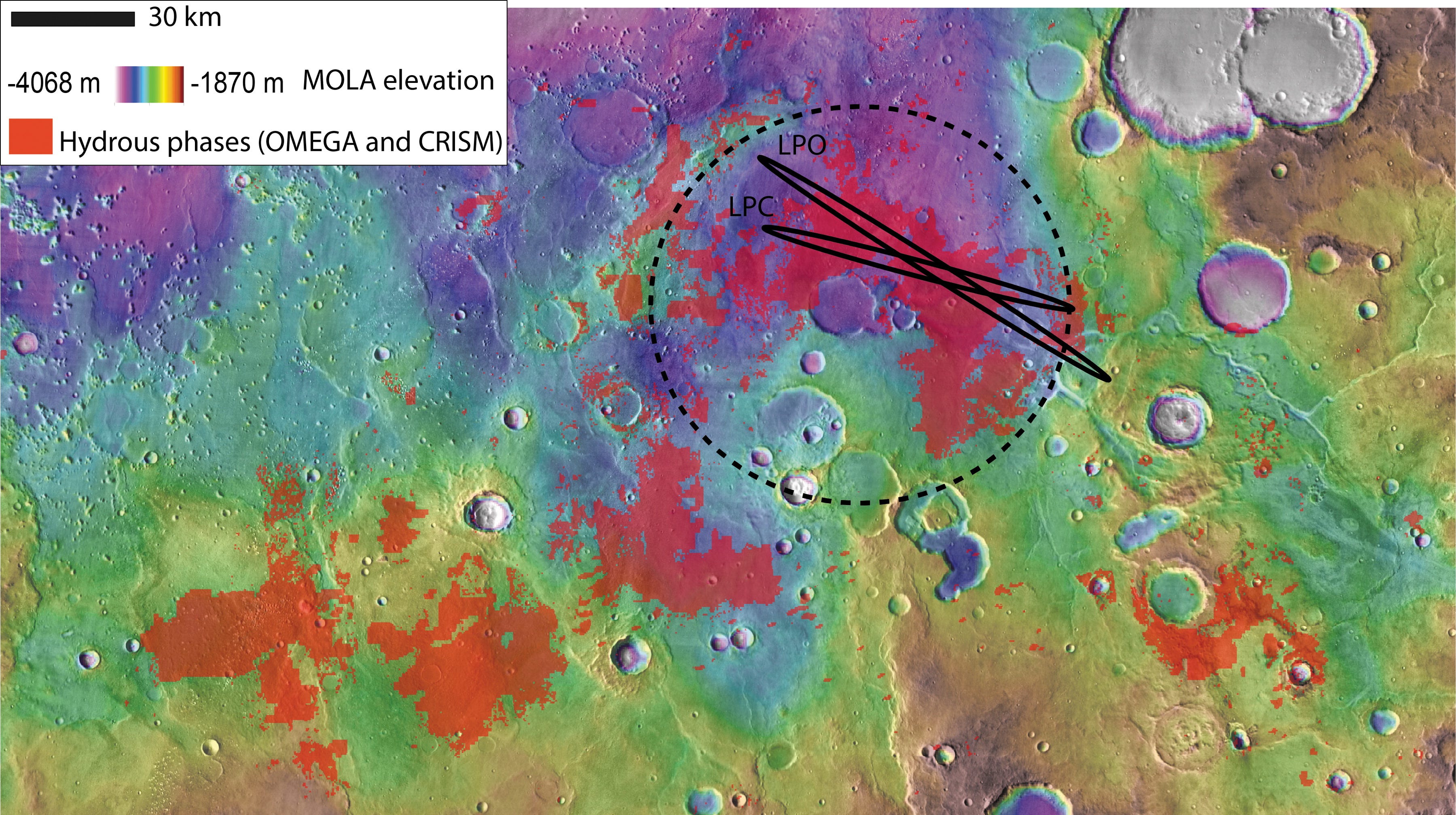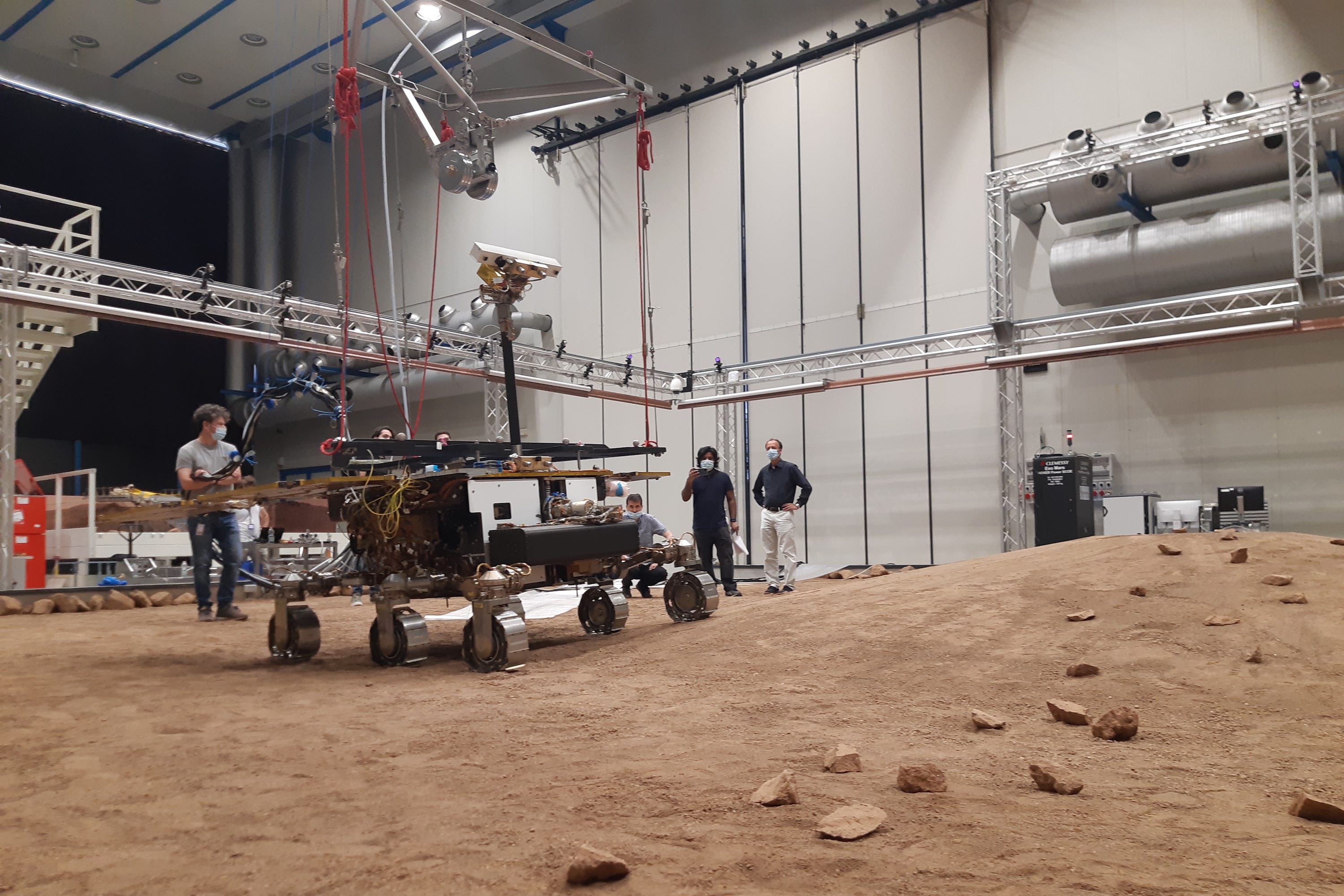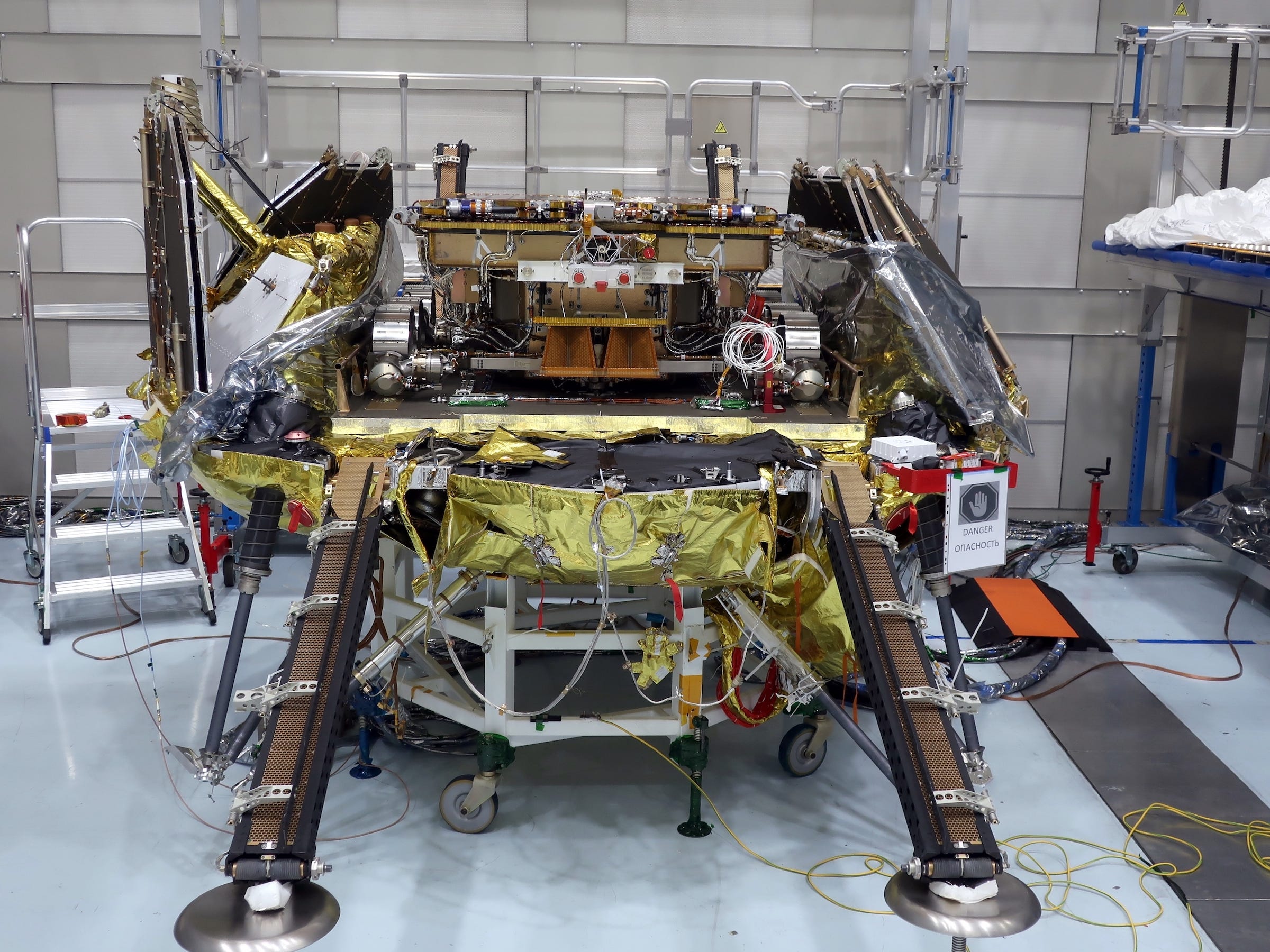ExoMars 2022: The Kazachok lander and Rosalind Franklin rover
A joint European-Russian mission to find signs of life on Mars.
Note: Prompted by Russia’s invasion of Ukraine in February 2022, ESA has suspended the ExoMars rover mission. The mission will launch no earlier than 2026 with a new partner.
The European Space Agency (ESA) and the Russian space agency, Roscosmos, inked a partnership last decade to find out if life ever existed on Mars. That intent is embedded in the program’s name, ExoMars, where ‘Exo’ refers to exobiology, the study of life beyond Earth.
ExoMars is made up of two Mars missions. The first—Trace Gas Orbiter—was launched in 2016 to study the likelihood of present Martian life from orbit. The second mission, ExoMars 2022, will launch in September 2022 to hunt for signs of past life on Mars’ surface.
ExoMars 2022 has two surface elements: the stationary platform Kazachok, named after a Russian folk dance, and the Rosalind Franklin rover, named after the prominent British scientist who helped discover DNA’s structure. Rosalind Franklin is Europe’s first Mars rover and is designed to detect preserved signatures of life unlike any mission before.

How will ExoMars 2022 land on Mars?
Before launch, the surface platform and the rover will be housed inside the descent module, the element to be used for the Mars landing. The descent module will be connected to a carrier module, which will carry the combined stack to Mars through interplanetary space. The stacked modules will launch on a Russian Proton rocket at the end of September 2022 and reach Mars in June 2023.
As Mars nears, the descent module will separate from the carrier module and slam Mars’ atmosphere at about 21,000 kilometers per hour. To cut down most of that excessive velocity, the descent module will use its thermal shielding and two parachutes as brakes. When the spacecraft finds itself descending slower than the speed of sound, it will use its sensors to determine its height from the ground and fire its engines accordingly to slow down enough to be able to deploy its legs for a safe touchdown.

How will Kazachok study the surface of Mars?
Once on Mars, the Rosalind rover will drive off Kazachok via ramps and move on to perform scientific investigations while Kazachok will remain stationary to image and study changes in the immediate surroundings for at least one Earth year.
Three spectrometers onboard will analyze the composition of the atmosphere and quantify the amount of water vapor in it. Kazachok will also monitor seasonal variations in the dust environment, and in air and soil temperatures. Further, it will measure local magnetic fields using a magnetometer, study the planet’s internal structure using radio science experiments and a seismometer, look for underground water, and monitor radiation levels.
The landing site of ExoMars 2022
In order to increase the chances of the Rosalind rover finding signatures of past martian life, ESA went through a rigorous process to select its landing site over six years. The rover will explore the Oxia Planum region of Mars, a 3.9 billion years old clay-rich area surrounded by ancient valley systems, all strongly hinting at a watery past. Notably, Oxia Planum was a candidate landing site for NASA’s Perseverance rover.

There are signs of volcanic activity in the region, which may have overlaid the clay and other aqueous deposits. This could’ve preserved any life imprints below the surface, protected against the planet’s harsh radiation environment. These deposits have been exposed by erosion only within the last few hundred million years, giving the Rosalind rover a great opportunity to look for preserved remnants of microbial life.
How will the Rosalind rover look for signs of past life on Mars?
The six-wheeled Rosalind rover is designed to travel several kilometers in Oxia Planum over the length of its mission. Two panoramic stereo cameras and a high-resolution imager on its mast will help identify best sites for the rover’s comprehensive instruments to analyze in detail. Aiding this task would be the rover’s infrared spectrometer, which will identify rocks altered by water in Mars’ past and water-bearing minerals on them.
For the most intriguing of such rocks, the rover will closely inspect them at sub-centimeter scale—like a geologist with a hand lens—to help scientists better understand the chain of events that formed and shaped these rocks. This closeup imager can also identify preserved biofilm traces of any ancient microbial colonies that might have thrived in a watery environment.

Since finding signatures of past Martian life is likelier below the surface, as that affords protection from surface radiation, the Rosalind rover has a 2-meter drill to collect deeper samples than any previous Mars mission. Further, unlike other missions which rely on surface imagery and data to select areas to drill, the Rosalind rover will also use a ground-penetrating radar to let scientists see up to 3 meters underground. It will also employ its neutron spectrometer to detect hydrogen, an indirect sign of water, to locate promising underground water-rich deposits. Having such holistic information about all promising locations will help scientists find optimal drilling points.
While the Rosalind rover drills Mars’ surface, a miniature spectrometer embedded inside the drill will image the walls of the borehole and determine its mineral makeup, providing scientists context for the collected samples. Once the rover has collected a drill sample, three spectrometers onboard will study it in microscopic detail.
A visible-plus-infrared spectrometer will identify molecules and water-bearing minerals in the samples, helping scientists determine if the region was ever habitable. A Raman spectrometer will detect organic molecules within the samples, providing direct information on if Mars had specific organic compounds related to microbial life as we know it. Lastly, a gas chromatograph will detect even small concentrations of organic molecules in the samples, and determine their chirality, a chemical property, to tell us if they formed because of microbial life or by natural means.
The Rosalind rover thus provides us an unprecedented and promising shot at finding out if microbial life existed and thrived on Mars.
Preparing for Mars
Since operating a rover on Mars involves a time lag of 4 to 24 minutes, it limits what a rover can do daily. ESA has thus designed the Rosalind rover to be highly autonomous and agile, an ability also useful as ESA prepares technologies for future Mars exploration.
The rover can autonomously and safely navigate to target destinations by avoiding rocks and other hazards, drive over boulders the size of its wheels, and negotiate steep slopes. If it gets stuck in soft or fluffy sand, it can lift each of its wheels independently to dig into and sweep along the surface—what ESA calls “wheel walking”—to get out of it. ESA conducted several roving tests on simulated Mars terrain with a test model to verify these abilities.

ESA and Roscomos have been conducting such extensive tests on various aspects of the ExoMars 2022 mission for years. This includes drill tests on hard rock, several parachute tests with one more scheduled later in 2021, testing Mars-like mission operations with a model rover 11,000 kilometers away, and more.
Next stop: the launch pad in September 2022 for a boost to Mars.
Originally published at The Planetary Society.
Like what you read? Support me to keep me going.
